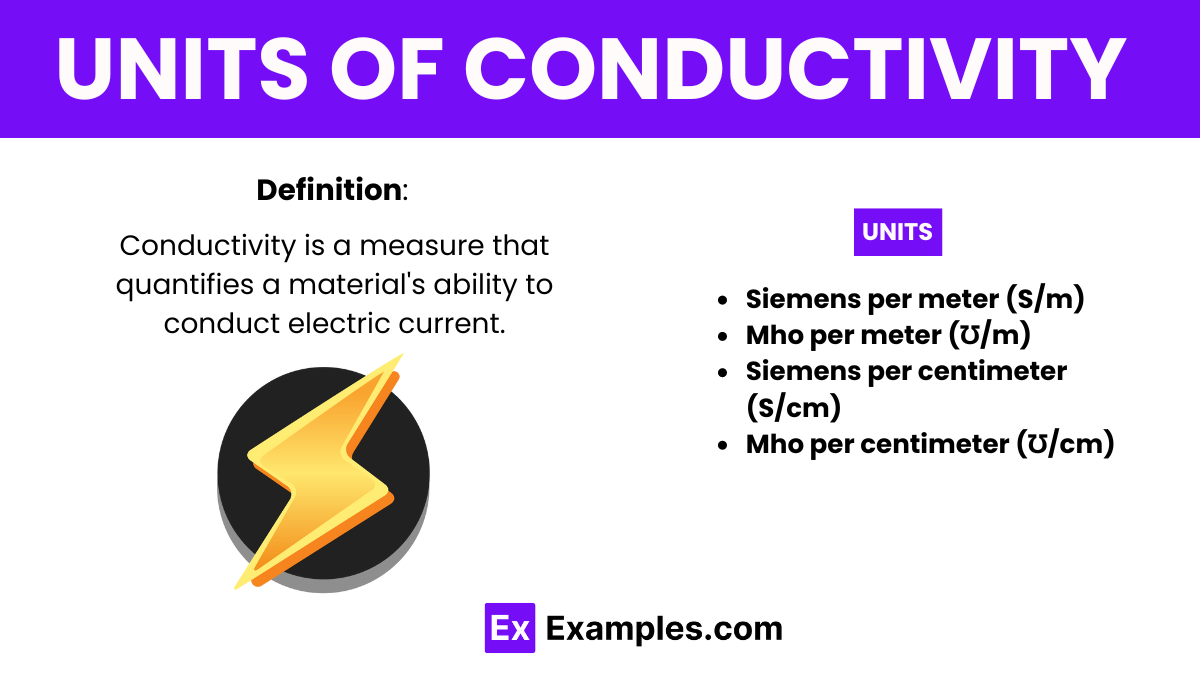What is the SI unit of electrical conductivity?
Siemens per meter (S/m)
Ohms per meter (Ω/m)
Farads per meter (F/m)
Henries per meter (H/m)


Conductivity is a measure that quantifies a material’s ability to conduct electric current. It is crucial in fields ranging from materials science to electrical engineering, where understanding how well substances allow the flow of electric charge can influence the design and functionality of devices.
Transitioning to more specific applications, another common unit is the Siemens per centimeter (S/cm). This unit is particularly useful in chemistry, where it helps to evaluate the conductivity of solutions, indicating the level of ions present.
Additionally, the mho per meter (℧/m), equivalent to Siemens per meter, is used. Though older, this unit still appears in various scientific contexts, reinforcing its relevance in conductivity measurements.
The SI unit of conductivity is the Siemens per meter (S/m). This unit quantifies how easily electricity can flow through a material. It represents the conductance of a material where a current of one ampere can flow through a sample one meter in length with a potential difference of one volt.
The CGS (Centimeter-Gram-Second) unit of conductivity is the reciprocal second(s⁻¹). In the CGS system, conductivity is sometimes referred to in terms of mho per centimeter (℧/cm), where mho is the reciprocal of the ohm, the unit of electrical resistance. This unit measures the electrical conductance of a material per centimeter of length, indicating how well the material can conduct an electrical current.
| Unit | Symbol |
|---|---|
| Siemens per Meter | S/m |
| Mho per Meter | ℧/m |
| Siemens per Centimeter | S/cm |
| Mho per Centimeter | ℧/cm |
The Siemens per meter is the SI unit of electrical conductivity. It measures the ability of a material to conduct an electric current and is defined as the conductivity of a material in which a current density of one ampere per square meter is produced by an electric field of one volt per meter.
Mho per meter, also expressed as Siemens per meter, is used interchangeably with S/m. The term “mho,” being ohm spelled backwards, signifies the reciprocal of resistance (ohm).
This unit is commonly used in chemistry, especially in the context of ionic solutions and conductive liquids. It measures the conductivity of a material where a current of one ampere is conducted through a material one centimeter in length under the influence of one volt.
Similar to Siemens per centimeter, mho per centimeter quantifies the conductivity of materials, particularly in liquid or solution form, facilitating precise measurements in electrochemistry and related fields.

Here is a table format for the conversion factors between different units of conductivity, such as Siemens per meter (S/m), Siemens per centimeter (S/cm), and their reciprocal values in Mho per meter (℧/m) and Mho per centimeter (℧/cm). These units are essentially equivalent but are presented to match your request:
| Unit | Siemens per meter (S/m) | Siemens per centimeter (S/cm) | Mho per meter (℧/m) | Mho per centimeter (℧/cm) |
|---|---|---|---|---|
| Siemens per meter (S/m) | 1 | 100 | 1 | 100 |
| Siemens per centimeter (S/cm) | 0.01 | 1 | 0.01 | 1 |
| Mho per meter (℧/m) | 1 | 100 | 1 | 100 |
| Mho per centimeter (℧/cm) | 0.01 | 1 | 0.01 | 1 |
Siemens per Centimeter to Mho per Centimeter
Specific conductivity is measured in Siemens per meter (S/m), reflecting how well a material conducts electricity per unit length.
Conductivity is quantified in Siemens per meter (S/m), ensuring accurate measurement of a material’s ability to conduct electrical current.
The symbol for conductivity is σ (sigma), commonly used in formulas to represent the electrical conductivity of materials.
Text prompt
Add Tone
10 Examples of Public speaking
20 Examples of Gas lighting
What is the SI unit of electrical conductivity?
Siemens per meter (S/m)
Ohms per meter (Ω/m)
Farads per meter (F/m)
Henries per meter (H/m)
Which of the following units is commonly used for thermal conductivity?
Watts per meter per Kelvin (W/m·K)
Joules per meter per Kelvin (J/m·K)
Volts per meter per Kelvin (V/m·K)
Amperes per meter per Kelvin (A/m·K)
What unit is used to measure electrical conductivity in the cgs (centimeter-gram-second) system?
Siemens per centimeter (S/cm)
Ohms per centimeter (Ω/cm)
Mhos per centimeter (mho/cm)
Siemens per meter (S/m)
How is the unit Siemens per meter (S/m) related to Ohm's law?
It is the reciprocal of resistivity
It is the product of resistivity
It is the square of resistivity
It is the same as resistivity
What is the unit of thermal conductivity in the Imperial system?
British thermal units per foot per hour per degree Fahrenheit (BTU/ft·hr·°F)
Joules per foot per hour per degree Fahrenheit (J/ft·hr·°F)
Watts per foot per hour per degree Fahrenheit (W/ft·hr·°F)
Calories per foot per hour per degree Fahrenheit (cal/ft·hr·°F)
What does the unit "S/m" represent in the context of material properties?
Specific heat capacity
Electrical conductivity
Thermal conductivity
Magnetic permeability
Which of the following units is equivalent to Siemens per meter?
Ohms per meter (Ω/m)
Amperes per meter (A/m)
Mhos per meter (mho/m)
Farads per meter (F/m)
If a material has a conductivity of 0.5 S/m, what is its resistivity?
2 Ω·m
0.5 Ω·m
1 Ω·m
0.2 Ω·m
What is the conductivity of a material with a resistivity of 10 Ω·m?
0.1 S/m
10 S/m
0.01 S/m
1 S/m
Which unit is used to express the thermal conductivity of a material in the SI system?
Watts per meter per Kelvin (W/m·K)
Joules per meter per Kelvin (J/m·K)
Volts per meter per Kelvin (V/m·K)
Amperes per meter per Kelvin (A/m·K)
Before you leave, take our quick quiz to enhance your learning!

